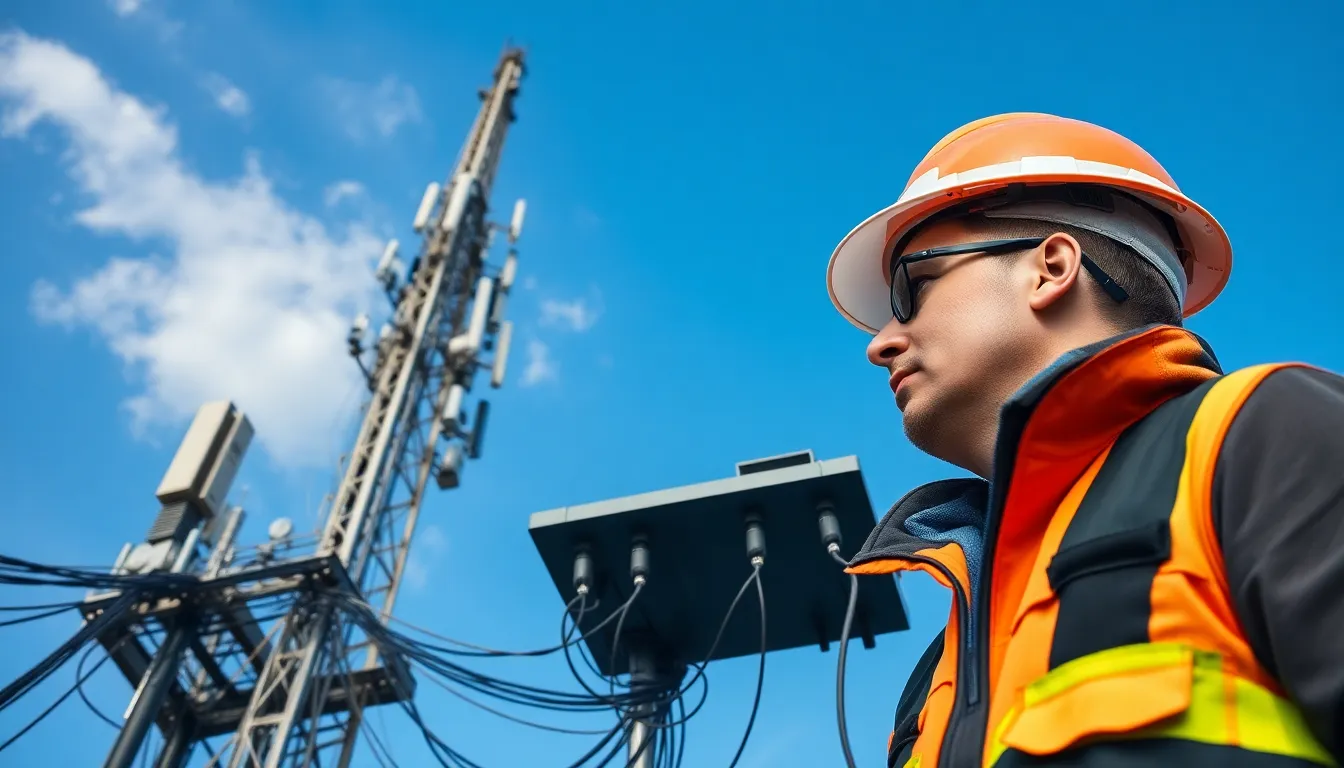In today’s fast-paced digital world, phone infrastructure development plays a crucial role in connecting people and businesses. As technology evolves, the demand for reliable and efficient communication networks has surged. This evolution not only enhances personal interactions but also drives economic growth and innovation across various sectors.
From urban centers to remote areas, the expansion of mobile networks ensures that everyone has access to essential services. With advancements in 5G technology and the growing importance of internet connectivity, the focus on developing robust phone infrastructure is more vital than ever. Understanding the challenges and opportunities in this field can provide valuable insights into the future of communication and connectivity.
Table of Contents
ToggleOverview of Phone Infrastructure Development
Phone infrastructure development involves the construction and enhancement of networks that facilitate communication. It encompasses various technologies, including cellular networks and fiber optics. Effective infrastructure supports voice, data, and multimedia transmission, impacting both individual users and businesses.
Key aspects of phone infrastructure development include:
- Network Expansion: The deployment of additional cell towers and base stations increases coverage in urban and rural areas. This expansion improves accessibility for users.
- Technology Upgrades: Upgrading existing systems to incorporate newer technologies, such as 5G, enhances speed and reliability. Increased bandwidth caters to the growing demand for data-intensive applications.
- Investment in Fiber Optics: Implementing fiber-optic cables boosts network performance. High-speed internet enables various services, from streaming to telemedicine.
- Regulatory Support: Government policies impact infrastructure projects. Supportive regulations can streamline processes and encourage private investment in telecommunications.
- Sustainability Initiatives: Eco-friendly practices are increasingly integrated into infrastructure projects. Utilizing renewable energy sources and minimizing waste contributes to environmental goals.
Research indicates that effective phone infrastructure development drives economic growth. Markets with robust communication networks experience higher productivity levels and increased innovation. As technology continues to evolve, ongoing investment remains critical to meeting future connectivity demands.
Key Components of Phone Infrastructure

Phone infrastructure relies on essential components that enable effective communication networks. These components include both hardware and software systems that facilitate connectivity and performance.
Network Hardware
Network hardware comprises the physical devices necessary for communication. This equipment includes:
- Cell towers: Structures that transmit and receive signals, expanding coverage across various areas.
- Base stations: Facilities that connect mobile devices to the network, managing user connections and ensuring optimal performance.
- Repeaters: Devices that amplify signals in areas with weak reception, boosting communication quality in remote locations.
- Routers: Equipment that directs data traffic efficiently, optimizing the flow of information between users and the internet.
- Fiber optic cables: High-capacity wires that transmit data at lightning speed, providing the foundation for reliable communication infrastructure.
Software Systems
Software systems play a critical role in managing network operations. These systems include:
- Network management software: Platforms that monitor and optimize performance, helping to identify and resolve issues in real-time.
- Billing systems: Applications that track usage, enabling efficient invoicing and management of customer accounts.
- Security software: Solutions that protect networks from unauthorized access and cyber threats, ensuring user data remains secure.
- Data analytics tools: Software that analyzes usage patterns and network performance, helping operators make informed decisions for future upgrades.
- Application servers: Infrastructure that supports services such as video calls and messaging, enhancing user experience through various applications.
Investing in robust hardware and software systems forms the backbone of effective phone infrastructure, facilitating seamless communication while addressing the evolving demands of users.
Historical Context and Evolution
Phone infrastructure development has roots that trace back over a century, evolving through various technological advancements to meet the demands of society. Understanding this evolution reveals how crucial reliable communication networks are for progress in personal and economic realms.
Early Developments
The inception of phone infrastructure began with the telegraph in the 19th century, which laid the groundwork for voice communication. Alexander Graham Bell’s invention of the telephone in 1876 marked a significant milestone, leading to the establishment of local phone lines. By 1900, the United States boasted over a million telephones, accelerating the growth of telephone networks. The introduction of switchboards facilitated connections between calls, further streamlining communication.
During the 1920s and 1930s, long-distance communication emerged with the development of transcontinental telephone lines. These innovations enabled people to connect across vast distances, enhancing both personal and business communications. By the 1960s, the introduction of direct dialing and rotary phones transformed user experience, allowing individuals to dial numbers without operator assistance.
Modern Advances
Modern phone infrastructure reflects significant technological advancements, primarily driven by the shift from analog to digital systems. The rollout of mobile communication began in the 1980s, with the deployment of 1G technology that allowed basic voice communication. This developed into 2G technology in the 1990s, introducing text messaging and improved capacity.
The 2000s marked the introduction of 3G and 4G technologies, enabling high-speed internet access and mobile data services. These advancements laid the groundwork for further innovations, such as smartphones, which rely heavily on robust infrastructure for seamless connectivity. The advent of 5G technology in the 2020s represents the latest leap, offering higher speeds, lower latency, and the potential for countless applications in various fields, from telemedicine to smart cities.
Continued investment in fiber optics and small cell technology aims to support increased demand for bandwidth and reduce network congestion. Regulatory frameworks also play a crucial role in encouraging private investments that drive infrastructure development forward. Modern advances underscore the importance of adaptive networks that can meet evolving communication needs and sustain economic growth.
Challenges in Phone Infrastructure Development
Numerous challenges hinder phone infrastructure development, impacting the ability to meet connectivity demands effectively. Addressing these obstacles proves crucial for network enhancement and scalability.
Technical Challenges
Technical challenges include outdated infrastructure, insufficient bandwidth, and high deployment costs. Outdated infrastructure complicates upgrades to newer technologies, leading to inefficiencies in network performance. Insufficient bandwidth limits the capacity for data transmission, directly affecting user experience. High deployment costs deter service providers from investing in new infrastructure, leading to slower network expansion and modernization. Additionally, the rapid evolution of technology results in compatibility issues, thus making integration with existing systems complex. Providers often face difficulties in maintaining consistent service quality amid these technical constraints.
Regulatory Issues
Regulatory issues significantly influence phone infrastructure development. Complex permitting processes delay construction and upgrades for new cell towers and fiber optic installations. Local, state, and federal regulations can impose restrictions on tower placement and operations, limiting providers’ flexibility. Compliance with diverse regulations across jurisdictions adds complexity, requiring significant administrative resources. Furthermore, inadequate policies for spectrum allocation can hinder advancements in mobile technologies. To foster infrastructure growth, increased collaboration between regulatory bodies and telecommunications companies becomes essential.
Future Trends in Phone Infrastructure Development
Innovations in phone infrastructure development continue to shape the future of communication technology. Emphasis on advanced technologies like 5G and sustainability plays a critical role in meeting future connectivity demands.
5G and Beyond
5G technology represents a significant leap in phone infrastructure, offering speeds up to 100 times faster than 4G. This advancement enables real-time communication essential for applications such as autonomous vehicles and smart cities. Enhanced mobile broadband, ultra-reliable low latency communication, and massive machine-type communication are key features of 5G. Industry leaders predict that the deployment of 5G networks will accelerate innovation in sectors such as healthcare, education, and entertainment. Future trends may include the integration of 6G technology, aiming for even higher data rates and immersive experiences through technologies like holography and advanced augmented reality.
Sustainability Considerations
Sustainability has become a paramount focus in phone infrastructure development. Telecommunications companies are adopting eco-friendly practices to minimize their environmental impact. Renewable energy sources, such as solar panels and wind turbines, are increasingly utilized to power cell towers and data centers. Additionally, companies are investing in energy-efficient network equipment that reduces carbon emissions. These sustainable initiatives not only address environmental concerns but also improve operational efficiency and reduce long-term costs. Regulatory pressures and public awareness on climate change will likely drive future investments in green technologies within the telecommunications sector.
Phone infrastructure development is pivotal in shaping the future of communication and connectivity. As technology evolves the demand for efficient and reliable networks grows. The advancements in 5G and fiber optics illustrate how investment in modern infrastructure can enhance user experience and drive economic growth.
Addressing the challenges within this sector requires collaboration among stakeholders and a commitment to sustainability. By embracing innovation and eco-friendly practices the telecommunications industry can ensure that everyone has access to essential services. The ongoing evolution of phone infrastructure will play a crucial role in connecting people and fostering new opportunities in an increasingly digital world.






